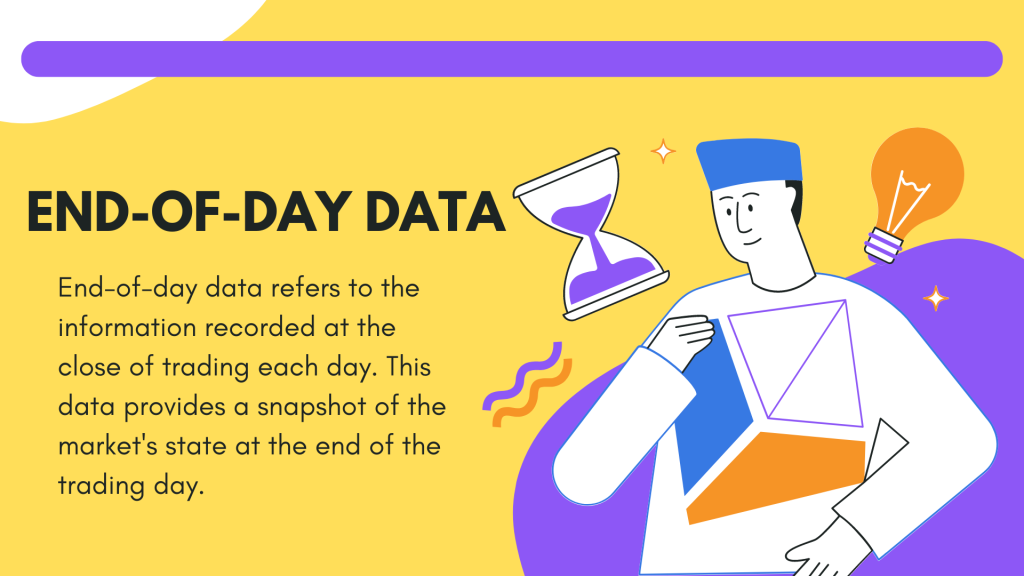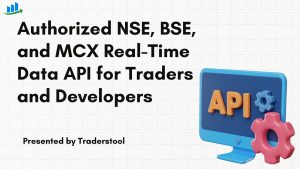When it comes to trading, having the right information at the right time can make a huge difference. Two common types of data that traders use are real-time data and end-of-day data. Both have their benefits and drawbacks, and choosing the right one for your trading strategy depends on what kind of trader you are. Let’s break down these two types of data to help you decide which might be better for your trading goals.
What is Real-Time Data?

Real-time data is live information about market prices, trading volume, and other financial metrics as they happen. This data updates continuously throughout the trading day, giving traders up-to-the-minute insights into market movements.
Current Market Prices: The latest price of a security or asset, updated every moment as trades occur.
Trading Volume: The number of shares or contracts traded in real time, indicating the level of market activity.
Order Book Information: The list of buy and sell orders at different price levels, showing market depth and liquidity.
Bid-Ask Spread: The difference between the highest price a buyer is willing to pay and the lowest price a seller will accept.
News Feeds: Real-time updates on market-moving news and events that might impact prices.
What is End-of-Day Data?

End-of-day data refers to information collected at the close of trading each day. This data provides a snapshot of the market at the end of the day, including closing prices, trading volumes, and other metrics.
Closing Prices: The final price at which a security or asset was traded at the end of the trading day.
Trading Volume: The total number of shares or contracts traded throughout the day.
High and Low Prices: The highest and lowest prices reached during the trading day.
Opening Prices: The price at which a security started trading at the beginning of the day.
Adjusted Closing Prices: Closing prices adjusted for events like stock splits, dividends, or rights offerings.
Pros and Cons Of Real-time data
| Pros of Real-Time Data: | Cons of Real-Time Data: |
| Immediate Updates: You get the latest information as soon as it’s available, which is crucial for making quick decisions. | Cost: Real-time data services can be expensive, especially for advanced features. |
| Better for Active Trading: If you’re a day trader or engage in frequent trades, real-time data helps you react to market changes instantly | Information Overload: With constant updates, it can be challenging to focus on what’s important. |

Pros and Cons Of End-of-day data
| Pros of End-of-Day Data: | Cons of End-of-Day Data: |
| Cost-Effective: Generally cheaper than real-time data, making it accessible for more traders. | Delayed Information: You might miss out on intraday price movements that could impact your trades. |
| Less Overwhelming: Since it updates only once a day, it’s easier to analyze and can help you focus on longer-term trends. | Limited for Active Traders: Not as useful for those who need to make rapid decisions based on real-time market conditions. |
Which Data is Right for Your Trading Strategy?
Hybrid Approach: Some traders use both types of data. For example, they might use real-time data for intraday trades and end-of-day data for analyzing overall trends.
Day Traders and Scalpers: If you’re making quick trades and need the most current information, real-time data is likely your best bet. It allows you to capitalize on short-term price movements and execute trades quickly.
Swing Traders and Long-Term Investors: If your focus is on longer-term trends and you don’t need to react to every market tick, end-of-day data may be more suitable. It provides a broader view of the market and is generally more cost-effective.
List of source for Both Real-Time and End-of-Day Data

ValveNet Technologies:
- Overview: Provides free real-time and End-of-day data(without any delay), Extensive databases of past market data, useful for back-testing trading strategies and conducting detailed analysis.
- Website: ValveNet Technologies
TradingView
- Overview: Provides both real-time and historical data, along with charting tools and community features.
- Website: TradingView
Yahoo Finance
- Overview: Offers both real-time quotes (with a delay) and end-of-day data, along with financial news and analysis.
- Website: Yahoo Finance
Google Finance
- Overview: Provides both real-time and end-of-day data, along with market news and basic charting.
- Website: Google Finance
Alpha Vantage
- Overview: Offers real-time and end-of-day data through its API, suitable for both historical and current data needs.
- Website: Alpha Vantage
Conclusion:
Choosing between real-time and end-of-day data depends on your trading style and goals. Real-time data is perfect for those who need immediate updates and can handle the cost and complexity. End-of-day data suits those who prefer a broader view and a more manageable information flow. Consider your trading strategy, budget, and the level of detail you need to make the best choice.





